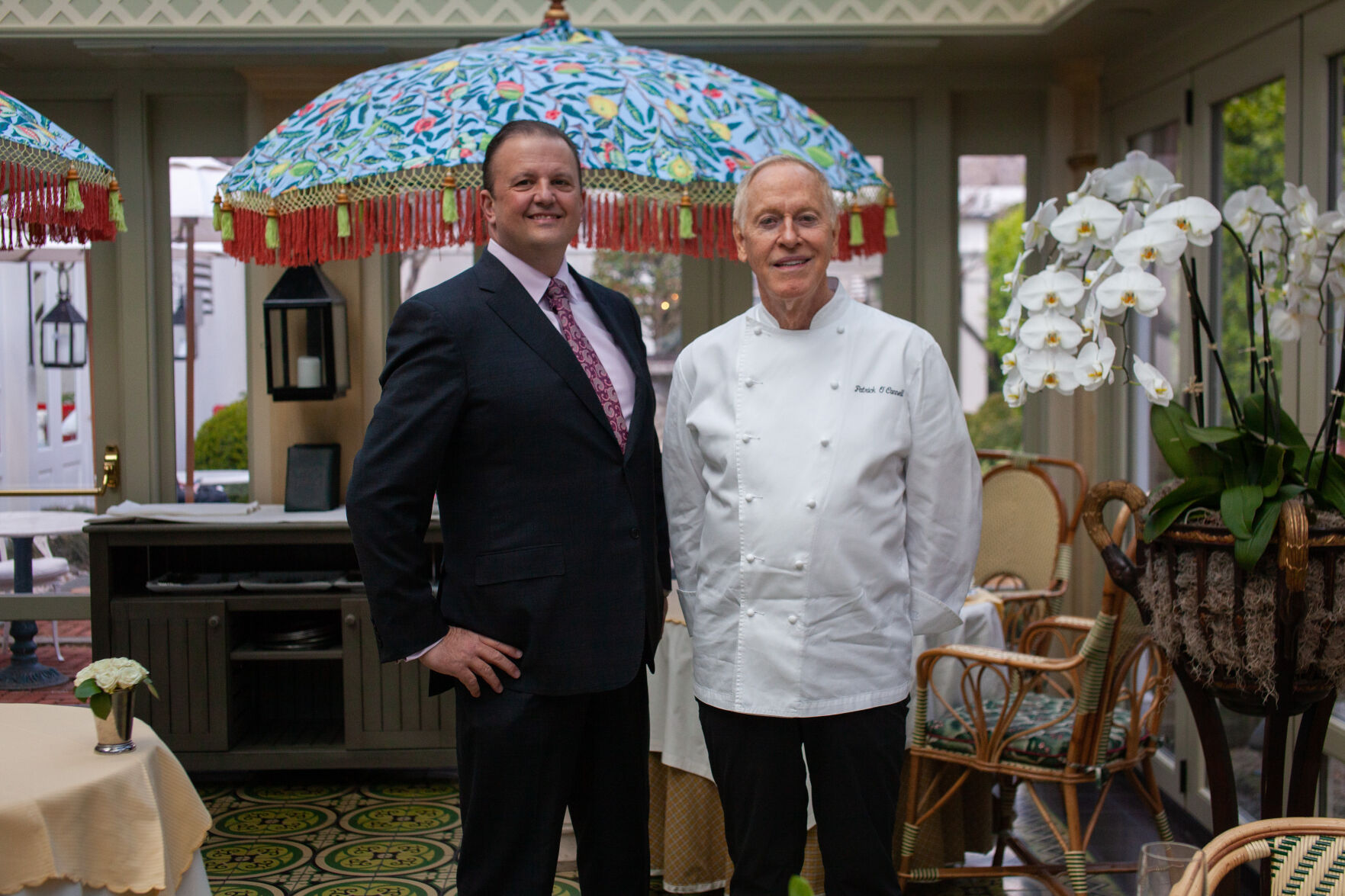The Inn at Little Washington, soon to celebrate its 45th birthday, has unveiled a bold expansion plan that pushes the county’s largest private enterprise into new territory, and presents the Town of Washington with significant changes in its streetscape and ambience.
A detailed design by Washington D.C.-based Franck & Lohsen Architects envisions 10 more guest rooms spread across various buildings, a spa with a pool, new outside dining areas, a reception building for guests, a carriage house with a “Juliet balcony,” plus a wine cellar and tasting hall. One existing building would be moved wholesale to a new location while the others would be connected by colonnaded walkways. The buildings, old and new, would enclose a sizable courtyard with a central fountain, plantings and areas for large events, relaxing or eating.
“The current plan has been forty-five years in the making,” said Patrick O’Connell, the Inn’s proprietor chef. “For me, it feels like the completion of a fascinating puzzle.”

Watch: Virtual walkthrough of Inn at Little Washington expansion
In a filing with the Town of Washington’s Architectural Review Board, the Inn at Little Washington including this animation showing the proposed expansion of its Washington, Virginia, campus. Animation by Franck & Lohsen Architects.
Washington Mayor Joe Whited, eager to present the town as business-friendly, welcomed the proposed transformation. “I’m encouraged they’re making an additional investment in Little Washington,” he said, adding that he supports a thorough review to ensure compliance with ordinances governing new construction. That process begins on Monday (May 15) when Washington’s Architectural Review Board begins scrutinizing the plans.

Photos: Inn at Little Washington’s planned expansion
Renderings of the Inn at Little Washington’s proposed expansion.
The architectural drawings emphasize new and much-altered buildings and fresh accents, but O’Connell insists that “when complete, the compound will look as if it has always been here.” The concept transforms a patchwork campus of renovated buildings into a coherent whole where affluent guests might step back from worldly pressures. And beyond the architectural details, the expansion represents a ratcheting-up of the O’Connell vision, solidifying three already evident trends if it comes to fruition:
A new business model: The revisions would move the Inn decisively past its founding Cinderella legend of a grimy gas station mutating into a globally renowned restaurant. What’s emerging now is a diversified hospitality enterprise that goes beyond exquisite meals. O’Connell hopes to keep guests in $1,000-a-night rooms for two or three days by offering the healthy indulgence of a spa, plus multiple spaces where guests can relax and restore. The proposed reception building underscores the importance of overnight guests, aiming to establish Washington as a rejuvenating destination rather than just a memorable dinner.
A new townscape: The Inn’s current patchwork campus of reimagined buildings would be knit together into a more connected whole. Existing buildings would be linked, with three major new structures joining them to frame a courtyard at the center of the establishment. The compound would be more coherent, but also more dense, surrounded by the town’s eclectic mix of residential, commercial and public buildings. By staying within its existing footprint, the Inn hopes to avoid the familiar complaint that it is gobbling up the town. Still, it was last year’s purchase of the building that once housed Middle Street Gallery and the now-shuttered Antiques at Middle Street for $1 million that enabled the consolidation.
Sign up for Rapp News Daily, a free newsletter delivered to your email inbox every morning.
A new financial base: Dining and guest room revenues would surge, pushing up the town’s receipt of meals and lodging taxes. These now exceed $600,000 a year, and town officials figure the expansion will bring in about $250,000 more. The added rooms also would generate new hook-up and usage fees to support the town’s costly water and sewer system. (A privately held enterprise, the Inn at Little Washington closely guards financial details of its operations, other than to note that its revenues would rise and recycle in the county.)
A change in management
The expansion program coincides with a significant change in management for the Inn. As O’Connell worked on finishing touches with the architects, Robert Fasce, the general manager, left for a new job as chief operating officer of the Rolling Rock Club in Ligonier, Pennsylvania.The move ended what many saw as an inspired partnership between a visionary chef and a get-it-done manager, who could translate inspirations into construction contracts, all the while managing a staff of about 250.

Inn_Robert Fasce and Patrick O’Connell (copy)
Robert Fasce, who recently departed as the Inn at Little Washington’s general manager, with chef proprietor Patrick O’Connell last spring.
Apparently taking the shift in stride, O’Connell noted that general managers tend to move to new jobs, and quickly elevated 37-year-old Andrew Wright to director of operations from director of culinary operations. Wright has been with the Inn for 12 years, among other things establishing a system of checklists to help cooks hone their skills — all the while aiming to avoid the harshly perfectionist atmosphere of many top-end restaurants.
“Andrew played an instrumental role in the construction and development of Patty O’s,” O’Connell said. “He came up through our kitchen in much the same way Bob did.” Another emerging talent is Fasce’s son Christopher, who has held various key jobs managing the flow of guests and meals at both Patty O’s and the Inn. Meanwhile, an international search firm is scanning for executive talent that might handle some of the functions for which the elder Fasce was responsible.
While O’Connell has challenged and inspired those he calls the “culinarians,” the 77-year-old founder and proprietor chef remains the driver of change at the enterprise, particularly its boldest-ever expansion. The move flows from a business philosophy more often associated with titans of industry than artistic chefs. “A business such as ours is either growing or dying,” O’Connell declared last year. “Standing still is not an option.”
But a clumsy, ill-designed expansion is not an option either. In a telling comment within a documentary about the Inn, O’Connell, about to sample a morsel from an aspiring sous-chef, stated, “It’s either art or it’s garbage.”
The same standard is applied to paint colors and upholstery at the Inn, and doubtless to the structural designs from Franck & Lohsen. Initial reactions have been positive. Former Washington Mayor John Fox Sullivan said he found the scope of the proposed transformation “jaw-dropping,” but added that he considers the proposed structures to be “lovely.”
Review and scrutiny
On Monday, May 15, Washington’s Architectural Review Board launches the review process that will determine how and whether the plan will go forward. The ARB will ensure the design complies with height and setback requirements, and more broadly whether the new configuration is compatible with the town and its streets. Zoning officials will review the plan, though town officials point out that the property is already zoned for the uses envisioned in the expansion.

inn at little washington expansion map
Following the ARB review, and possible architectural adjustments, Washington’s Planning Commission will study a site plan. Absent any snarls or complexities, the town Council will not be required to undertake a separate review. The Rappahannock County Board of Supervisors has no role in the process. However, ARB and Planning Commission meetings will be open to the public, and citizens outside the town will be invited to share their reactions, some of which are likely to be critical of the scope of the change, the sense of an enclosed campus for the Inn, or the threat of added traffic. Whited guesses the process will be wrapped up in a month or two.
Hampton Supervisor Keir Whitson, whose district includes the town of Washington, underscored the importance of the Inn’s economic contributions to the town and the county. “The Inn is the county’s largest employer, by far,” he said, “and I know many old-time, local people who have worked there, or still work there, and some for many years.” He added that he has real concern about the traffic congestion as the Inn’s operations expand, and called for careful analysis of where cars and trucks will travel and park.
A movable White House

Inn white house
A rendering of a relocated “White House,” home to a new spa.
Perhaps the plan’s most startling mutation involves the building known as “The White House.” Located near the Inn kitchen, the structure now provides offices for O’Connell and the senior staff, as well as space for kitchen tools and general storage. The expansion calls for moving the building to a new location, visually aligned to the Claiborne House on Gay Street. There, the White House would be expanded and turned into the Inn at Little Washington Spa, replete with cold and hot tubs, “treatment rooms,” sauna and steam rooms, a ground-level pool made possible by recent changes to town law, and terraces for outdoor lounging.
The shape-shifting changes won’t interrupt the flow of guests and food at the Inn and Patty O’s. “Because there is a party wall separating the Inn from the newly acquired property, many guests will not be aware anything is taking place on the other side of it,” O’Connell said.
As other septuagenarians ease up or dip into exercises of life-review, O’Connell evinces only pleasure in the present and a fascination with what comes next. “We have fun, eat well and get along, united by a common purpose — making people happy,” he said. “The next few years may be some of the most interesting we’ve ever experienced.”








